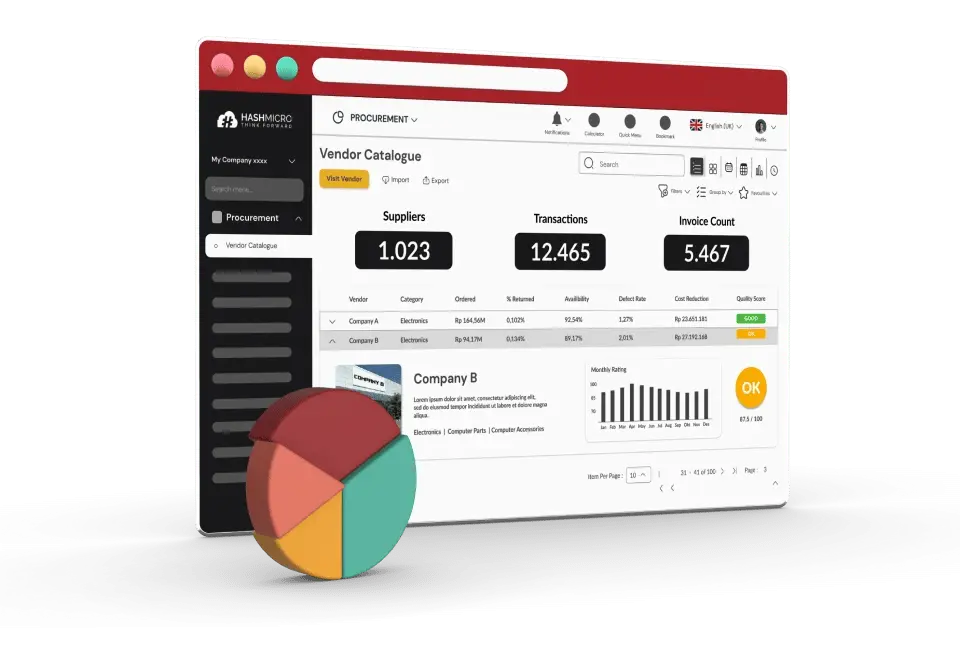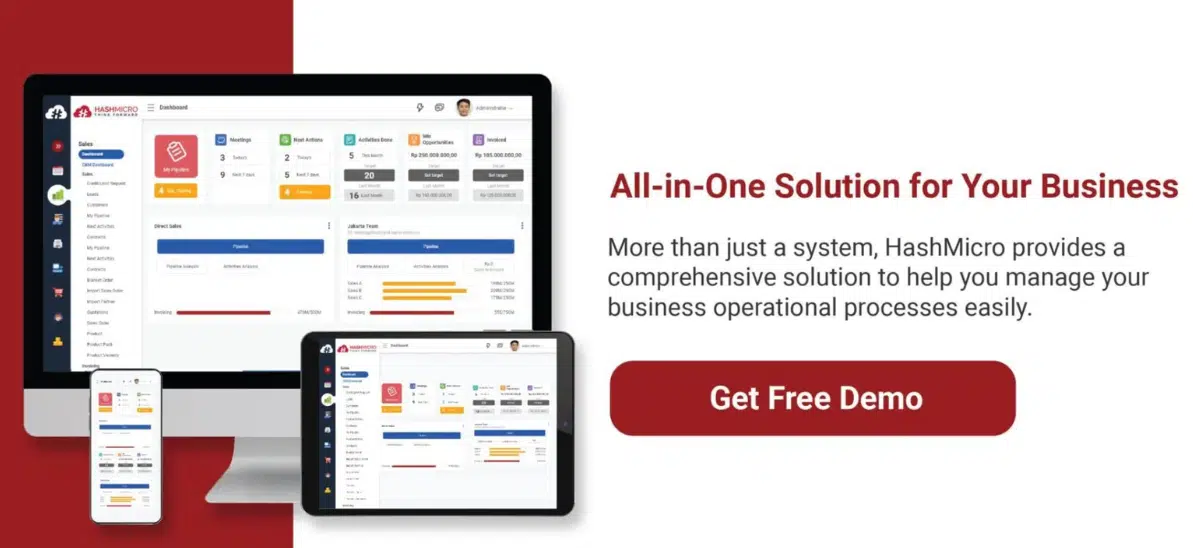Imagine your construction project operating without proper oversight—materials are delayed, contractor roles are unclear, and project timelines keep shifting. This type of disorganization doesn’t just affect delivery; it leads to budget overruns and damages your company’s reputation.
In Singapore, the need for streamlined procurement processes is more critical than ever. According to the Building and Construction Authority (BCA), total construction demand in Singapore is projected to range between S$32 billion and S$38 billion in 2024, driven by public housing developments, healthcare infrastructure, and transport projects like the Cross Island Line.
This article explores what procurement in construction truly means, outlines its key stages and methods, and discusses how using advanced tools like HashMicro Procurement Software can enhance efficiency. By the end, you’ll gain a clear understanding of how strategic procurement supports successful construction delivery in Singapore.
Key Takeaways
|
Table of Content:
Table of Content
What Is Procurement in Construction?
Procurement in construction refers to the structured process of acquiring goods, services, and works essential for completing a construction project. It encompasses everything from materials and labor to design services and subcontracts. Effective procurement ensures that projects meet time, quality, and cost expectations.
The procurement phase is vital to the entire construction lifecycle. It aligns resources with objectives and supports the successful delivery of infrastructure. Without a solid procurement strategy, even well-planned projects face budget overruns and delays.
In Singapore, construction procurement is influenced by government regulations, public tendering procedures, and market dynamics. The Building and Construction Authority (BCA) mandates strict compliance in vendor selection, sustainability, and project accountability, making procurement strategies especially crucial in local projects.
How Does the Construction Procurement Process Work?
Construction procurement is a structured series of activities to secure the necessary materials, services, and labor to complete a construction project. According to insights from Autodesk and Quickbase, understanding the key stages in this process is crucial for ensuring cost control, timely execution, and contract compliance.
- Planning and Budgeting: This stage involves defining the project scope, goals, and procurement requirements. It includes determining material specifications, cost estimates, and procurement timelines aligned with the construction lifecycle.
- Tendering and Bidding: Here, the team prepares and releases Requests for Proposals (RFPs), Quotations (RFQs), or Invitations to Tender (ITTs). The aim is to attract qualified contractors and suppliers with competitive bids.
- Evaluation and Selection: Bids are assessed based on pricing, technical capabilities, past performance, and regulatory compliance. This ensures that the chosen vendor can deliver within scope and budget constraints.
- Contract Awarding: Once a vendor is selected, the contract negotiation and signing take place. This formalizes the agreed-upon terms, conditions, responsibilities, and project deliverables.
- Performance Monitoring: Contractor performance is closely monitored during project execution. Key metrics include delivery timelines, material quality, adherence to specs, and issue resolution.
- Closeout: This final stage involves project handover, completion documentation, final payments, and a thorough audit to ensure contractual obligations have been met.
Still unsure whether a procurement strategy is the right fit for your construction projects? No worries! Try a pricing scheme today and consult with our experts to explore how this solution can transform the way you manage sourcing, vendor selection, and contract execution. Click the banner below to get started!
Types of Construction Procurement Methods
1. Traditional (Design-Bid-Build)
This method separates design and construction responsibilities, with the client appointing a designer first and selecting a contractor through competitive bidding. It offers cost certainty and is widely used in public-sector projects. However, disconnecting between the design and construction phases may lead to miscommunication or delays.
2. Design and build
One contractor handles design and construction, allowing for streamlined coordination and faster delivery. This method reduces client risk and speeds up the overall process. However, since the contractor leads both phases, the client may have less influence over design details.
3. Management contracting
The client hires a construction manager who oversees multiple trade contractors, allowing design and construction to run concurrently. It enables flexibility in design changes during execution. This method suits complex projects but requires experienced project oversight.
4. Construction management
The client contracts with all trade contractors and coordinates with a construction manager. This offers greater control and transparency over cost and performance. It demands strong project leadership and active client participation throughout.
5. Public-Private Partnerships (PPP) / Private Financing Initiatives (PFI)
Private entities finance, build, and sometimes operate infrastructure projects in PPPs under long-term contracts. The government repays the investment over time, reducing upfront public expenditure. This model supports innovation and efficiency in delivering large-scale public projects in Singapore.
Key Roles in the Procurement Process
Successful construction procurement requires collaboration among several key roles, each contributing specific expertise and accountability. Clear communication and defined responsibilities among stakeholders are critical to managing risks and achieving project objectives.
1, Procurement manager
Oversees the entire procurement lifecycle, from planning and budgeting to vendor selection and contract enforcement. Ensures procurement activities align with regulations and project timelines while maintaining transparency and cost efficiency.
2. Clients
The project owners or developers fund the construction and define performance expectations. They initiate procurement by setting goals, approving budgets, and signing off on key decisions throughout the project.
3. Consultants
Typically, architects, engineers, or quantity surveyors develop detailed project specifications. They assist in bid evaluations and quality assurance and ensure technical compliance with design and regulatory requirements.
4. Contractors
Responsible for executing the construction work as outlined in the contract. They mobilize resources, manage subcontractors, and adhere to schedules and quality standards under the guidance of the procurement team.
5. Suppliers
Deliver raw materials, equipment, or services needed during construction. Their reliability impacts project timelines, cost control, and compliance with environmental or safety standards. Suppliers must maintain accurate documentation and align deliveries with project schedules to avoid costly delays or rework.
The Benefits of Procurement in Construction
Procurement is essential for the success of both the design and construction stages. The right strategy and expertise improve timelines, cost control, and coordination. Effective procurement brings consistent value to every project, regardless of the method used. Below are some of the core advantages of effective procurement in construction:
1. Time efficiency
Efficient procurement ensures the timely delivery of materials and services, helping projects stay on schedule and meet critical milestones. For example, the timely completion of Singapore’s Thomson-East Coast MRT Line relied heavily on synchronized procurement planning across multiple contracts.
2. Cost control
Procurement teams reduce financial waste and maintain spending within forecasted limits by securing competitive bids and managing budgets proactively. This approach was critical in projects like the Changi Airport Terminal 5 development to avoid overrun risks.
3. Improved coordination
Centralized procurement improves communication between clients, consultants, and contractors. It ensures smoother workflows and more transparent accountability, which has been instrumental in integrated public housing developments by HDB.
4. Enhanced risk mitigation
Structured procurement minimizes delays and contractor issues through better contract management and performance tracking. Singapore’s Downtown Line project benefited from risk-managed procurement processes that helped avoid significant cost and timeline setbacks.
5. Better resource allocation
Procurement helps align the supply of materials and services with actual project demands. By planning purchases and managing supplier performance, companies can avoid resource wastage or shortages. This allows for better coordination on-site and more strategic use of available assets.
Challenges in Construction Procurement
Construction procurement is a complex process that often encounters various challenges, impacting project timelines, budgets, and overall success. Understanding these challenges is crucial for stakeholders to develop effective strategies to mitigate risks and ensure smooth project execution. Below are five common challenges faced in construction procurement:
1. Supply chain disruptions
Unforeseen events such as natural disasters, pandemics, or geopolitical tensions can disrupt the supply chain, leading to delays in material delivery. These disruptions can halt construction activities, increase costs, and extend project timelines. Implementing diversified sourcing strategies and maintaining buffer stocks can help mitigate these risks.
2. Regulatory compliance issues
Navigating the complex web of local, national, and international regulations can be challenging. Non-compliance can result in legal penalties, project delays, or even cancellations. Staying updated with regulatory changes and engaging legal experts during procurement is essential.
3. Budget constraints and cost overruns
Inaccurate cost estimations and unforeseen expenses can lead to budget overruns. Fluctuating material prices and labor costs further exacerbate this issue. Implementing robust budgeting practices and contingency planning can help control costs.
4. Vendor reliability and performance
Selecting vendors without thorough due diligence can lead to issues like substandard materials, missed deadlines, or contractual disputes. Establishing strict vendor evaluation criteria and performance monitoring systems is vital to ensure reliability.
5. Communication breakdowns among stakeholders
Ineffective communication between clients, contractors, suppliers, and consultants can result in misunderstandings, errors, and project delays. Implementing centralized communication platforms and regular coordination meetings can enhance collaboration and information flow.
Best Practices in Construction Procurement
Construction procurement has become increasingly complex, but adopting best practices can help streamline processes, reduce risks, and enhance overall project success. Here are some of the most effective strategies:
1. Use of technology and digital tools
Leveraging digital tools like Building Information Modeling (BIM) and procurement software can significantly improve project management. These tools allow for better visualization, faster decision-making, and more accurate tracking of materials and progress. They also help reduce errors and improve communication between teams.
2. Standardizing documentation and workflows
Standardizing workflows and documentation ensures consistency across projects. It minimizes human errors and improves the efficiency of procurement tasks. With clear procedures, stakeholders can track activities seamlessly, making audits and compliance checks easier.
3. Sustainable procurement practices
Adopting sustainable procurement practices aligns with Singapore’s Green Plan 2030 and supports environmental conservation. Selecting eco-friendly materials, opting for energy-efficient solutions, and partnering with green-certified suppliers can significantly reduce the environmental impact of construction projects while contributing to long-term sustainability goals.
How to Improve Your Procurement Strategy
Improving your construction procurement strategy requires a structured, proactive approach that ensures efficiency, compliance, and long-term value. By following clear steps and reflecting critically on your current methods, you can build a procurement process that drives better outcomes for every project.
1. Step-by-step checklist to improve procurement strategy
- Define project needs clearly: Clearly define project requirements, timelines, and budgets to guide procurement. This alignment helps prevent miscommunication, delays, and scope creep.
- Establish a prequalified vendor list: Create a prequalified list of reliable vendors to ensure quality and compliance. This speeds up procurement by reducing repetitive checks and minimizing risks.
- Use E-Procurement platforms: Use e-procurement tools to digitize and streamline processes from tendering to payment. This enhances efficiency, transparency, and record-keeping across all procurement stages.
- Monitor KPIs throughout project stages: Monitor KPIs like cost, delivery, and compliance to track performance. Use dashboards for real-time insights and continuous improvement.
2. Evaluate your current approach
Reviewing your existing procurement strategy is essential to ensure it aligns with changing market dynamics and long-term goals. Contracts should be designed with flexibility in mind, allowing for adjustments in scope, pricing, or timelines without legal or operational hurdles. This adaptability ensures smoother project execution during unforeseen disruptions.
Encouraging supplier diversity strengthens resilience and innovation within the supply chain. Engaging vendors from varied backgrounds also supports ESG (Environmental, Social, and Governance) initiatives and enhances competitiveness, especially in projects that value inclusive and sustainable sourcing practices.
Key Trends Shaping the Future of Construction Procurement
The construction industry is undergoing significant changes driven by technology, sustainability, and inclusion. These trends improve procurement efficiency, enhance resilience, and support ethical practices. Adapting to these shifts is crucial for staying competitive and ensuring long-term success.
- Digital Transformation: The adoption of AI and cloud-based tools is revolutionizing procurement processes. These technologies improve efficiency, decision-making, and data management, driving faster and more accurate procurement cycles.
- ESG Compliance: There is a growing emphasis on environmental, social, and governance (ESG) factors in procurement. Companies are increasingly integrating sustainability into their procurement strategies, ensuring that projects adhere to eco-friendly and ethical standards.
- Supplier Diversity: The Inclusion of SMEs and local businesses is gaining traction. This fosters resilience in the supply chain and sparks innovation by diversifying the pool of ideas and solutions available to project teams.
Enhance Procurement Efficiency with HashMicro Procurement Software

By integrating HashMicro Procurement Software into your workflow, you gain a comprehensive solution that simplifies complex procurement tasks. From vendor management to inventory tracking, this tool ensures that every procurement decision is data-driven, cost-effective, and aligned with project goals.
Here are the various features of HashMicro’s e-procurement software:
- PO, RFQ & PR Management: You can easily create purchase requests and convert them into purchase orders, and send quotes to suppliers with just a few clicks through our efficient purchasing system.
- Work Order Receiving: With this feature, you can easily ensure that the company receives the right goods in the right quantities and maintain accurate records of all goods received.
- PR Approval Management: This feature can approve or reject purchase requests from different business locations, departments, or employees with just one click on the integrated procurement system.
- Online Portal for Suppliers: With this feature, vendors can upload their catalogs through the vendor portal, allowing easy access to product information. You can also improve the efficiency of the tendering process and enable companies to get the best deals.
- Blanket Order Management: Our e-procurement system enables the ordering of goods according to the price and schedule that has been agreed with the supplier, ensuring certainty and efficiency.
- Landed Cost Calculation: You can calculate the total cost of purchasing goods, including shipping, insurance, and customs clearance, providing an accurate picture of the total final cost involved in procuring the goods.
- Vendor Comparison on Tender with Hashy AI: Hashy compares vendor offers in real-time based on price, quality, delivery time, and performance history to help make informed decisions.
- RFQ Approval Management: Hashy automates the RFQ approval flow, sends notifications, and ensures quick responses for a smooth procurement process.
Conclusion
Strategic procurement is a critical element for the success of construction projects, particularly in the context of Singapore’s dynamic construction environment. It ensures timely delivery, cost efficiency, and high-quality standards. By adopting modern practices, including digital tools and sustainable procurement, contractors and developers can navigate challenges effectively and mitigate risks.
To streamline procurement, HashMicro Procurement Software offers solutions like vendor comparison, real-time inventory monitoring, and automated workflows. Ready to enhance your procurement process? Try a free demo today and experience efficient supply chain management with HashMicro!
Question About Procurement in Construction
-
What are the 5 main things in procurement?
Procurement typically involves five key elements:
– Need Identification: Determining the goods or services required for business operations.
– Supplier Evaluation and Selection: Assessing potential suppliers based on cost, quality, reliability, and compliance.
– Contract Negotiation: Establishing agreements that ensure favorable terms and conditions for both parties.
– Order Fulfillment: Managing the delivery of goods or services to meet specified requirements.
– Performance Review: Evaluating supplier performance and improving procurement strategies -
What is RFQ in procurement?
RFQ (Request for Quotation) is a formal document used by businesses to request price quotes from suppliers for specific goods or services. It outlines detailed requirements, enabling companies to compare offers and select the best option based on cost and quality.
-
What is the meaning of procurement in a project?
Procurement in a project refers to the process of acquiring goods, services, or resources from external suppliers to support project execution. It ensures that all project needs are met efficiently within budget and timeline constraints while maintaining quality standards.
-
What is the difference between procurement and purchasing
– Procurement is a strategic process that includes sourcing, negotiating contracts, managing supplier relationships, and ensuring long-term value. It focuses on maximizing profitability and efficiency.
– Purchasing, on the other hand, is transactional and involves activities like creating purchase orders, arranging payments, and acquiring goods/services to meet immediate needs.




































